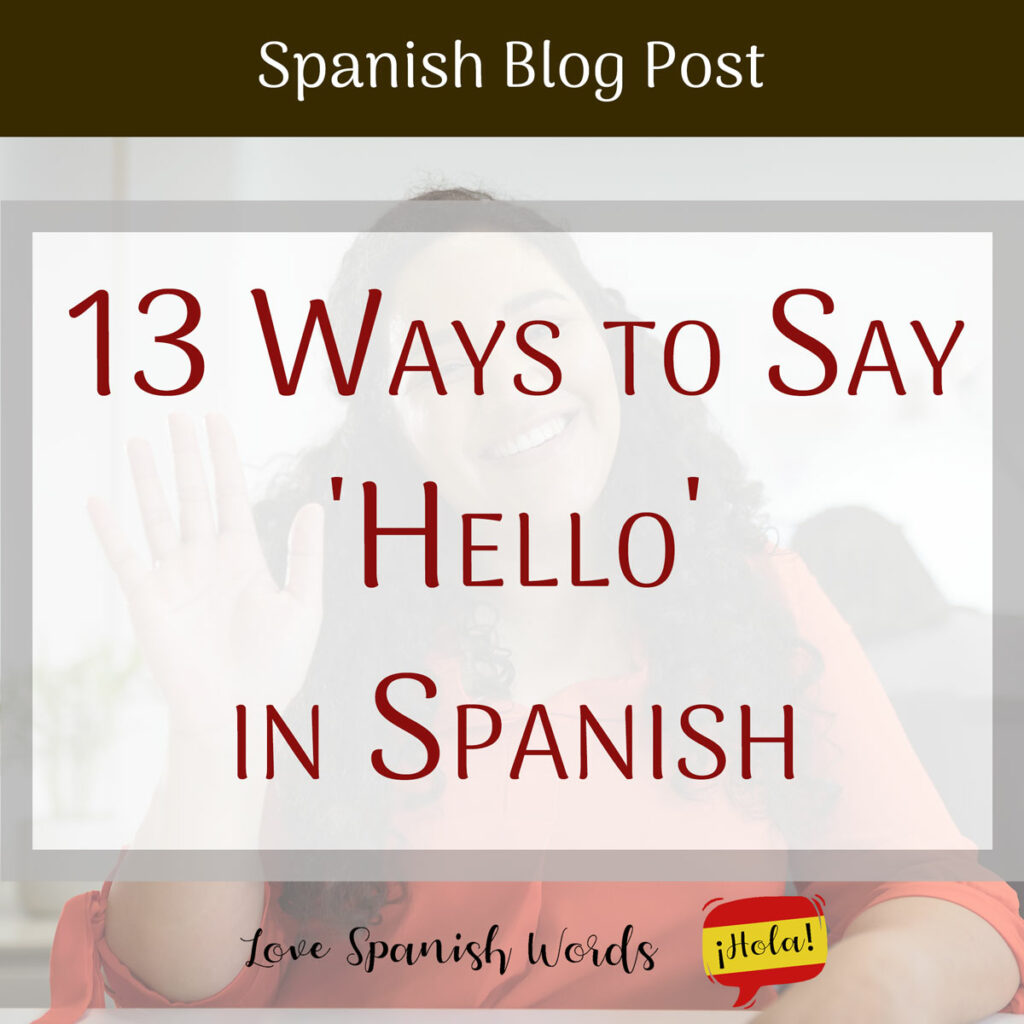Across the 21 Spanish-speaking countries in the world, there are over one hundred ways to say hello in Spanish! I won’t overwhelm you with all the various ways to greet someone, but I will share some of the most common words and phrases that can be understood across most of these countries.
As per any language, it’s important to know the formal and informal ways to greet someone because you don’t want to sound rude in formal settings, nor do you want to sound stiff in casual settings.
From the formal and kind greeting, Buenas tardes to the most casual and slang word, Quihubo, get ready to learn some of the most popular ways to say Hello in Spanish!

Hola
Let’s start with the most common greeting across Spanish-speaking countries, a simple hola. It translates to hello or hi. Hola can be used in any situation and setting or at any time of the day with friends, family, colleagues, or any casual and formal encounter with someone.
This means you can use it in formal or informal situations. It is often accompanied by the phrase, ¿Cómo estás? which means How are you?
Buenos Días / Buenas Tardes / Buenas Noches
These three phrases are the most popular greetings when walking into a room with people or greeting someone. They translate to Good Morning, Good Afternoon, and Good Evening respectively. Even though they are formal greetings, they can also be used with friends and family and in all casual settings.
Each phrase is strictly used with a corresponding time of the day. Buenos días is used anytime before noon. Buenas tardes is used anytime from noon to sunset. Buenas noches is used in the evening.
One thing to know is that although buenas noches is used for good evening, it translates to good night. Therefore, the phrase is also used to wish someone a good night and as a goodbye when you bid someone farewell at night.

Fun Fact: In some countries, some people say buen día, buena tarde, and buena noche instead.
Buenas
Buenas is a less formal way to say buenos días, buenas tardes, or buenas noches. However, it sounds a bit lazy so it’s best to keep the second word attached when greeting someone, especially in a formal setting.
When someone greets you with buenas, you can respond with the same word or with an hola. If you prefer, you can respond with one of the three phrases, buenos días, buenas tardes, or buenas noches, depending on the time of the day.
Note that buenos días becomes buenas and not buenos.

¿Cómo Está? / ¿Cómo Estás?
Although ¿Cómo está? or ¿Cómo estás? is normally said after greeting someone with Hola, it is also common to greet someone with a handshake and this phrase alone. It means, How are you?
Está and Estás equate to the English verb to be. In Spanish, está and estás are used for different people. Está is the formal version of the verb and it is used with people you respect, such as parents, elders, people of authority, or someone you don’t know. Estás is the informal version and can be used with friends, family, and anyone casual.
When greeted with a ¿Cómo Estás?, you can respond with Bien, gracias. ¿Y tu? (informal) or Bien, Gracias. ¿Y usted? (formal) which means Good, thank you. What about you?
¿Qué Tal?
¿Qué tal? is an informal way of saying How are you? to friends. It resembles the saying How’s it going? or What’s going on?
However, it can be used in a formal setting if accompanied by an hola in front of the phrase. Hola, ¿Qué tal? translates to “Hello, how are you?” If the word is used alone as a greeting, it’s preferable to use it in informal settings only.
¿Qué Onda?
Even though this slang phrase literally translates to What wave? it’s closer in meaning to What’s the vibe? or What’s up? This fun greeting is extremely informal and should only be used between close friends. It is best to avoid using it in casual or formal settings because you will sound disrespectful.
When a friend says ¿Qué onda? you can respond with the same phrase, or a simple nada, no mucho, or bien, aqui. Those phrases translate to nothing, not much, and good, just here.
You wouldn’t answer with bien or mal (good or bad) because the question doesn’t ask How are you? It asks, What’s going on? Therefore, you would answer with a phrase that describes what is going on in your life, to which most people tend to reply with nada (nothing).
However, if ¿Qué onda? is followed by ¿Cómo estás? (informal), you can respond with bien or mal (good or bad) because now you are answering the second question, How are you?

Fun Fact: This greeting is popular and widely used across México between friends, but may also be heard in other Spanish-speaking countries such as Guatemala, Honduras, Argentina, and Nicaragua.

¿Quihubo? / ¿Quiubo? / ¿Qué Hubo? / ¿Quibole?
These variations derive from the two words, ¿Qué hubo? which is the past tense meaning of What was there? and equates to the English expressions What’s new?, What’s been going on?, or What has happened?
This is another extremely informal slang greeting that should only be used with close friends. It’s very similar to the phrase ¿Qué onda? For this reason, when greeted with ¿Quihubo? you would respond in the same way you would for ¿Qué onda?
Depending on the Spanish-speaking country you’re in, it might slightly vary on how it’s said or written. It’s common to hear it combined with a second word, for example, ¿Quiubo parce? (friend) in Colombia, or ¿Quihubo güey? (buddy) in México.

Fun Tip: To use this phrase without it sounding like slang, you can say it in its grammatically correct form, ¿Que ha habido? which means, What has there been? or the shortened grammatically incorrect form, ¿Qué habido?
¿Cómo va? or ¿Cómo vas?
The word va is the simple present tense for the Spanish verb ir or to go in English. Therefore the phrase ¿Cómo va? or ¿Cómo vas? is a question that asks, How’s it going?
¿Cómo va? is the formal version and ¿Cómo vas? is the informal version. When responding to this greeting, a simple Bien, ¿Y tú? (informal) or Bien, ¿Y usted? (formal) is common. Another common response is, Todo bien, which means all is well.
Holi / Holiii
Holi, sometimes written with extra is (holiiii), is a cute and informal way to say hello between friends and is mostly used amongst young adults and teenagers, particularly girls. You can respond in the same way or with an hola. Although it can be a spoken greeting, it is most commonly used in text messaging and audio messaging with friends.

¡Ey!
¡Ey! is another informal greeting. It can be used in two ways. First, you can use it with your close friends and siblings when you see each other or when they call you by phone.
The second way to use it as a greeting is to say hello to someone from far away. For example, if you’re walking on the street and see a friend or someone you know on the other side, you can raise your hand as if waving, and yell out ¡Ey! It’s similar to saying hey in English.
To say Hey, what’s up? you would say ¡Ey, qué pasa! in Spanish.
Saludos
Saludos is the word for greetings. However, it’s not a word you use face-to-face to greet someone. Instead, saludos is used to send a hello to someone through someone else.
For example, if you are with a friend and they receive a phone call from their mother and you want your friend to say hello to her for you, you would tell your friend, Saludos a tú mamá. This means, greetings or hello to your mom.
Or, you could say salúdamela, which is the Spanish command for Say hi to her for me. Your friend would then tell her mother, Mi amiga te envía saludos which means, My friend sends you greetings.
¡Qué Milagro!
Across Latin America, it is common to use ¡Qué milagro! as a form of hello when running into someone you haven’t seen in a long time. Although it translates to What a miracle, it’s most similar to the English phrase long time no see.
This phrase is usually an expression of happiness or surprise and is commonly followed by the phrase, Cómo has estado? or How have you been?
¿Aló? / ¿Bueno?
When answering a phone call in Spanish, the greeting changes. Instead of saying hola, the greeting becomes ¿Aló? or ¿Bueno? and sounds more like a question. Bueno is more commonly used in México whereas aló is used across other Spanish-speaking countries to answer the phone.
Both these words are casual ways of answering a phone call. If however you are expecting a formal call, it is best to answer the phone with buenos días, buenas tardes, or buenas noches.

Informal and Slang Greetings by Country
As you can see, there are many ways to say hello in Spanish. The informal slang greetings are fun to learn when you visit the different Spanish-speaking countries and it’s always nice to look them up before visiting. Here is a quick list of some popular slang greetings across some countries:
- Dominican Republic: ¿Qué lo qué? which equates to “What’s up?” and is written as klk in text messaging.
- Costa Rica: Pura Vida translates to pure life but is a hello, and has many other meanings too.
- Cuba: ¿Qué bola? means What’s up? and the word bola is taken from volar which means to fly, so it means What’s flying?
- Chile: ¿Wena? means good day and derives from buena and changed to wena.
- Venezuela: Épale meaning hi.
- Argentina: Hola, che meaning Hey there.
- Spain: ¿Qué te cuentas? meaning What do you tell? but means What’s new? or How’s it going?
- México: ¿Qué rollo? and ¿Qué pedo? meaning What’s up?

